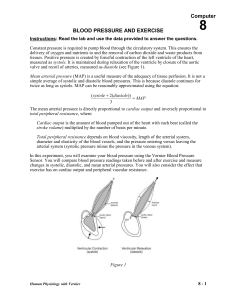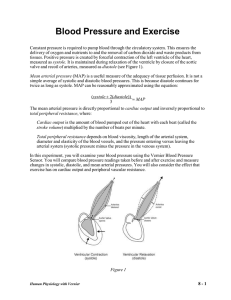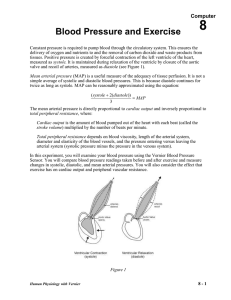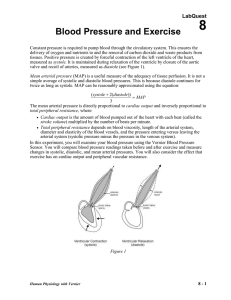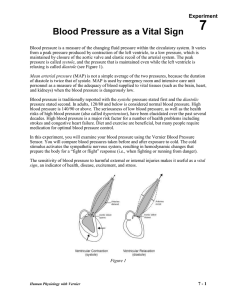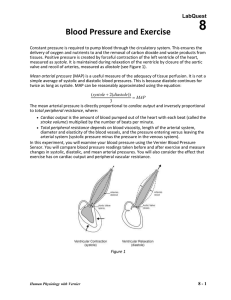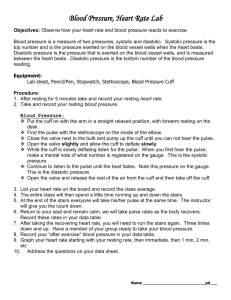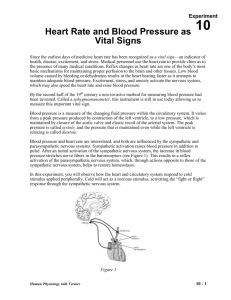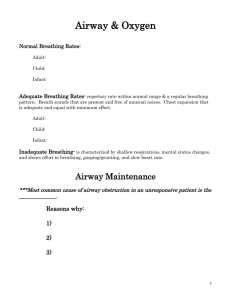Blood Pressure and Exercise
advertisement
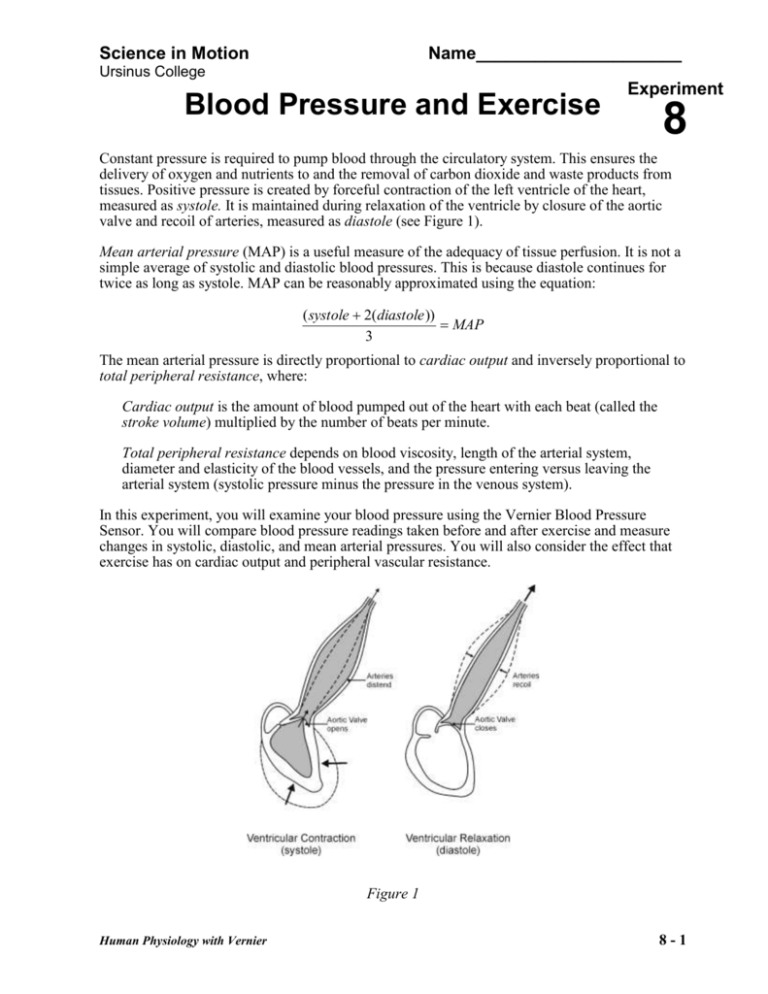
Science in Motion Name_____________________ Ursinus College Blood Pressure and Exercise Experiment 8 Constant pressure is required to pump blood through the circulatory system. This ensures the delivery of oxygen and nutrients to and the removal of carbon dioxide and waste products from tissues. Positive pressure is created by forceful contraction of the left ventricle of the heart, measured as systole. It is maintained during relaxation of the ventricle by closure of the aortic valve and recoil of arteries, measured as diastole (see Figure 1). Mean arterial pressure (MAP) is a useful measure of the adequacy of tissue perfusion. It is not a simple average of systolic and diastolic blood pressures. This is because diastole continues for twice as long as systole. MAP can be reasonably approximated using the equation: ( systole 2(diastole )) MAP 3 The mean arterial pressure is directly proportional to cardiac output and inversely proportional to total peripheral resistance, where: Cardiac output is the amount of blood pumped out of the heart with each beat (called the stroke volume) multiplied by the number of beats per minute. Total peripheral resistance depends on blood viscosity, length of the arterial system, diameter and elasticity of the blood vessels, and the pressure entering versus leaving the arterial system (systolic pressure minus the pressure in the venous system). In this experiment, you will examine your blood pressure using the Vernier Blood Pressure Sensor. You will compare blood pressure readings taken before and after exercise and measure changes in systolic, diastolic, and mean arterial pressures. You will also consider the effect that exercise has on cardiac output and peripheral vascular resistance. Figure 1 Human Physiology with Vernier 8-1 Experiment 8 OBJECTIVES In this experiment, you will Obtain graphical representation of blood pressure. Compare changes in systolic, diastolic, and mean arterial pressures with exercise. Use blood pressure readings and pulse to infer changes in cardiac output and peripheral vascular resistance with exercise. MATERIALS computer Vernier computer interface Logger Pro Vernier Blood Pressure Sensor watch with second hand PROCEDURE Select one person from your lab group to be the subject. Part I Baseline Blood Pressure 1. Connect the Blood Pressure Sensor to the Vernier computer interface. Open the file “08 Blood Pressure Exercise” from the Human Physiology with Vernier folder. 2. Attach the Blood Pressure Sensor to the blood pressure cuff if it is not already attached. There are two rubber tubes connected to the cuff. One tube has a black Luer-lock connector at the end and the other tube has a bulb pump attached. Connect the Luer-lock connector to the stem on the Blood Pressure Sensor with a gentle half turn. 3. Attach the Blood Pressure cuff to the upper arm, approximately 2 cm above the elbow. The two rubber hoses from the cuff should be positioned over the biceps muscle (brachial artery) and not under the arm (see Figure 2). 4. Have the subject sit quietly in a chair and avoid moving his or her arm or hand during blood pressure measurements. 5. Click to begin data collection. Immediately begin to pump until the cuff pressure reaches at least 160 mm Hg. Stop pumping. 6. Immediately feel for the radial pulse (place two or three fingers over the radial artery in the wrist proximal to the thumb) in the arm without the Blood Pressure cuff. Count the beats over 20 s. Multiply by 3 to obtain the number of beats per minute. Record this value in Table 1. Figure 2 7. During this time the systolic, diastolic, and mean arterial pressures will be calculated by the software. These values will be displayed on the computer screen. When the blood pressure readings have stabilized (after the pressure drops to 50 mm Hg), the program will stop calculating blood pressure. At this point, you can terminate data collection by clicking . Release the pressure from the cuff, but do not remove it. 8. Store your data by choosing Store Latest Run from the Experiment menu. 9. Enter the systolic, diastolic, and mean arterial pressures in Table 1. 8-2 Human Physiology with Vernier Blood Pressure and Exercise Part II Blood Pressure After Exercise 10. With the blood pressure cuff still attached to his/her arm, the subject from Part I of the experiment should run in place for 2 minutes. At the end of 2 minutes, the subject should sit down, placing his or her arm on the table surface. 11. Click to begin data collection. Immediately begin to pump until the cuff pressure reaches at least 170 mm Hg and then stop pumping. 12. Immediately feel for the radial pulse (place two or three fingers over the radial artery in the wrist proximal to the thumb) in the arm without the Blood Pressure cuff. Count the beats over 20 s. Multiply by 3 to obtain the number of beats per minute. Record this value in Table 2. 13. During this time the systolic, diastolic, and mean arterial pressures will be calculated by the software. These values will be displayed on the computer screen. When the blood pressure readings have stabilized (after the pressure drops to 50 mm Hg), the program will stop calculating blood pressure. At this point, you can terminate data collection by clicking . Release the pressure from the cuff, and remove the cuff from the subject’s arm. 14. Enter the systolic, diastolic, and mean arterial pressures in Table 2. DATA Table 1–Baseline Blood Pressure Systolic pressure (mm Hg) Diastolic pressure (mm Hg) Mean arterial pressure (mm Hg) Pulse (bpm) Table 2–Blood Pressure After Exercise Systolic pressure (mm Hg) Diastolic pressure (mm Hg) Mean arterial pressure (mm Hg) Pulse (bpm) DATA ANALYSIS 1. Describe the trends that occurred in the systolic pressure, diastolic pressure, mean arterial pressure, and pulse with exercise. Why must these changes occur? Human Physiology with Vernier 8-3 Experiment 8 2. Assume that your stroke volume (amount of blood pumped out of the heart with each beat) is 75 mL/beat when resting and it increases to 100ml/beat during exercise what is the increase in volume pumped in one minute. Use your pulse rate data to calculate the increase. 2. Pulse pressure is the difference between systolic pressure (peak pressure during active contraction of the ventricles) and diastolic pressure (the pressure that is maintained even while the left ventricle is relaxing). Describe the change in pulse pressure seen with exercise. Which component of the blood pressure is most responsible for this change? 3. A change in pulse pressure can be seen in a variety of medical conditions. What would you expect to happen to the pulse pressure in the following examples? (a) In atherosclerosis there is a hardening of the arterial walls. (b) A damaged aortic valve does not seal properly and allows blood to flow back into the ventricle during diastole. 4. Why is high blood pressure considered dangerous? 8-4 Human Physiology with Vernier
